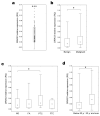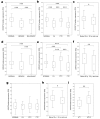Expression of RASSF1A, DIRAS3, and AKAP9 Genes in Thyroid Lesions: Implications for Differential Diagnosis and Prognosis of Thyroid Carcinomas
- PMID: 38203733
- PMCID: PMC10778957
- DOI: 10.3390/ijms25010562
Expression of RASSF1A, DIRAS3, and AKAP9 Genes in Thyroid Lesions: Implications for Differential Diagnosis and Prognosis of Thyroid Carcinomas
Abstract
Thyroid carcinoma is the primary endocrine malignancy worldwide. The preoperative examination of thyroid tissue lesion is often unclear. Approximately 25% of thyroid cancers cannot be diagnosed definitively without post-surgery histopathological examination. The assessment of diagnostic and differential markers of thyroid cancers is needed to improve preoperative diagnosis and reduce unnecessary treatments. Here, we assessed the expression of RASSF1A, DIRAS3, and AKAP9 genes, and the presence of BRAF V600E point mutation in benign and malignant thyroid lesions in a Polish cohort (120 patients). We have also performed a comparative analysis of gene expression using data obtained from the Gene Expression Omnibus (GEO) database (307 samples). The expression of RASSF1A and DIRAS3 was decreased, whereas AKAP9's was increased in pathologically changed thyroid compared with normal thyroid tissue, and significantly correlated with e.g., histopathological type of lesion papillary thyroid cancer (PTC) vs follicular thyroid cancer (FTC), patient's age, tumour stage, or its encapsulation. The receiver operating characteristic (ROC) analysis for the more aggressive FTC subtype differential marker suggests value in estimating RASSF1A and AKAP9 expression, with their area under curve (AUC), specificity, and sensitivity at 0.743 (95% CI: 0.548-0.938), 82.2%, and 66.7%; for RASSF1A, and 0.848 (95% CI: 0.698-0.998), 54.8%, and 100%, for AKAP9. Our research gives new insight into the basis of the aggressiveness and progression of thyroid cancers, and provides information on potential differential markers that may improve preoperative diagnosis.
Keywords: AKAP9; BRAF V600E; DIRAS3; RASSF1A; signalling pathways; thyroid carcinoma; thyroid nodules.
Conflict of interest statement
The authors declare no conflict of interest.
Figures






Similar articles
-
Detection of BRAFV600E mutation on fine needle aspiration specimens of thyroid nodule refines cyto-pathology diagnosis, especially in BRAF600E mutation-prevalent area.Clin Endocrinol (Oxf). 2006 Nov;65(5):660-6. doi: 10.1111/j.1365-2265.2006.02646.x. Clin Endocrinol (Oxf). 2006. PMID: 17054470
-
Frequent silencing of RASSF1A via promoter methylation in follicular thyroid hyperplasia: a potential early epigenetic susceptibility event in thyroid carcinogenesis.JAMA Surg. 2014 Nov;149(11):1146-52. doi: 10.1001/jamasurg.2014.1694. JAMA Surg. 2014. PMID: 25229773
-
DNA Methylation-Based Method to Differentiate Malignant from Benign Thyroid Lesions.Thyroid. 2019 Sep;29(9):1244-1254. doi: 10.1089/thy.2018.0458. Epub 2019 Aug 16. Thyroid. 2019. PMID: 31328658
-
BRAF mutation in papillary thyroid carcinoma: pathogenic role and clinical implications.J Chin Med Assoc. 2010 Mar;73(3):113-28. doi: 10.1016/S1726-4901(10)70025-3. J Chin Med Assoc. 2010. PMID: 20230995 Review.
-
Diagnosis and management of differentiated thyroid cancer using molecular biology.Laryngoscope. 2013 Apr;123(4):1059-64. doi: 10.1002/lary.23838. Epub 2013 Feb 12. Laryngoscope. 2013. PMID: 23404751 Review.
References
-
- Lee S.T., Kim S.W., Ki C.S., Jang J.H., Shin J.H., Oh Y.L., Kim J.W., Chung J.H. Clinical implication of highly sensitive detection of the BRAF V600E mutation in fine-needle aspirations of thyroid nodules: A comparative analysis of three molecular assays in 4585 consecutive cases in a BRAF V600E mutation-prevalent area. J. Clin. Endocrinol. Metab. 2012;97:2299–2306. doi: 10.1210/jc.2011-3135. - DOI - PubMed
-
- Pizzato M., Li M., Vignat J., Laversanne M., Singh D., La Vecchia C., Vaccarella S. The epidemiological landscape of thyroid cancer worldwide: GLOBOCAN estimates for incidence and mortality rates in 2020. Lancet Diabetes Endocrinol. 2022;10:264–272. doi: 10.1016/S2213-8587(22)00035-3. - DOI - PubMed
MeSH terms
Substances
Supplementary concepts
Grants and funding
LinkOut - more resources
Full Text Sources
Medical
Molecular Biology Databases
Research Materials

